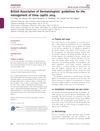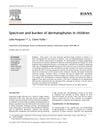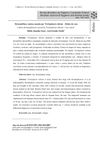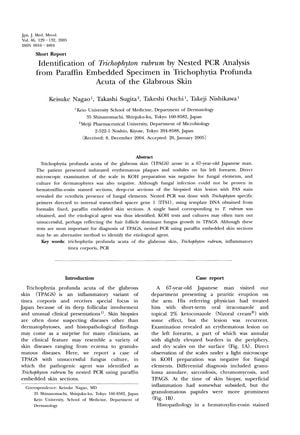TLDR Nested PCR can reliably identify fungal infections when traditional methods fail.
A 67-year-old Japanese man with trichophytia profunda acuta of the glabrous skin (TPAGS) presented with erythematous plaques and nodules on his forearm. Traditional diagnostic methods, including KOH preparation and culture, failed to detect fungal elements. However, deep-cut sections stained with PAS revealed fungal presence. Using nested PCR with Trichophyton-specific primers on DNA from paraffin-embedded skin sections, Trichophyton rubrum was identified as the causative agent. This study suggested that nested PCR could be a reliable alternative for identifying fungal infections in cases where conventional methods are unsuccessful.
 7 citations
,
January 2003 in “Nippon Ishinkin Gakkai Zasshi”
7 citations
,
January 2003 in “Nippon Ishinkin Gakkai Zasshi” The girl's scalp infection healed well with terbinafine treatment.
May 2024 in “Journal of Fungi” Tinea capitis in adults, especially postmenopausal Black women, needs prompt treatment with oral antifungals to avoid scarring.
 156 citations
,
September 2014 in “British journal of dermatology/British journal of dermatology, Supplement”
156 citations
,
September 2014 in “British journal of dermatology/British journal of dermatology, Supplement” Accurate diagnosis and effective oral treatment are key to managing tinea capitis and preventing its spread.
 32 citations
,
June 2017 in “Journal of infection/The Journal of infection”
32 citations
,
June 2017 in “Journal of infection/The Journal of infection” The document concludes that terbinafine is effective for treating scalp fungal infections in children and recommends not excluding them from school during treatment, while also highlighting the need for updated treatment guidelines due to changing infection patterns.
102 citations
,
January 2020 in “Recent Patents on Inflammation & Allergy Drug Discovery” Tinea capitis in young children requires oral antifungal treatment for effective management.
 January 2021 in “Revista brasileira de higiene e sanidade animal”
January 2021 in “Revista brasileira de higiene e sanidade animal” A dog with skin lesions was successfully treated for a human-type fungal infection.




